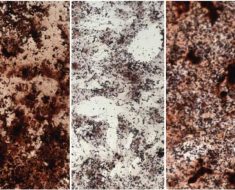
- Spinach extract could have promoted the healing of wounds in rats similar to wounds experienced by people with diabetes, says a new study.
- Spinach is full of compounds that may have produced this effect, including vitamins, antioxidants, glutamine, and zinc, but the mechanism that may allow spinach extract to promote wound healing remains unclear.
- The most decisive wound-healing benefit was seen in rats who received spinach extract before the ulcers were inflicted.
A new study in rats suggests that extracts of spinach, Spinacia oleracea, could help promote healing of diabetic ulcers.
Chronic diabetic ulcers are a serious problem for people with diabetes, and can persist for months or even years. About 15% of people with diabetes have a lower-extremity ulcers that will not heal, often resulting in amputation. Chronic diabetic ulcers affect roughly 6.3% of the world’s overall population.
A new study — published in Scientific Reports — found that spinach extract can improve the healing of diabetic wounds and promote weight loss, a benefit for people with diabetes who are often overweight.
Both water- and alcohol-based spinach extracts effective
The researchers investigated the efficacy of two types of spinach extract. One was water-based (aquatic), and the other was alcohol-based. They both promoted healing, though the alcohol-based extract had a slight edge.
The study involved 72 adult rats, divided into six groups:
- Group A — rats with diabetes who were tube-fed 300 milligrams per kilogram (mg/kg) weight of saline solution for a month
- Group B — rats without diabetes who were tube-fed 300 mg/kg of saline solution for a month
- Group C — rats with diabetes who were tube-fed 300 mg/kg of S. oleracea aquatic extract for a month
- Group D — rats without diabetes who were tube-fed 300 mg/kg of S. oleracea alcoholic extract for a month
- Group E — rats without diabetes who were tube-fed 300 mg/kg of S. oleracea aquatic extract for a month, exposed to diabetes by the researchers, and then tube-fed 300 mg/kg of S. oleracea aquatic extract for an additional month
- Group F — rats without diabetes who were tube-fed 300 mg/kg of S. oleracea alcoholic extract for a month, exposed to diabetes by the researchers, and then tube-fed 300 mg/kg of S. oleracea alcoholic extract for an additional month.
The study observed the strongest, fastest wound recovery in Groups E and F, rats who received 2 months of spinach extract, before and after induction of diabetes mellitus.
The differences in some measures of wound healing were not significant at the end of the study period as wound healing had occurred in all groups.
Wound healing was assessed from observations of wounds induced by the researchers using a sterile biopsy punch. They measured a variety of factors in addition to healing itself, including VEGF, blood sugar levels, and weight loss.
Why do wounds heal slower in diabetes?
Registered dietitian nutritionist Yelena Wheeler, not involved in the study, explained to Medical News Today how wound healing occurs.
“Red blood cells are the foundation of new tissue as it creates collagen. Collagen forms new skin tissue, which grows over the wound, causing it to heal and decrease in size,” she told us.
When a wound occurs, white blood cells, proteins, nutrients, and oxygen-bound red blood cells are sent for clotting and healing, registered dietitian nutritionist Cesar Sauza, also not involved in the study, added. “All of these compounds have their role in wound-healing,” he said.
For people with diabetes, however, “high blood sugar levels can lead to stiffened blood vessels, slowing down circulation and reducing oxygen supply to the tissues,” explained integrative registered dietitian nutritionist Kelsey Costa, not involved in the research.
“This also impairs the function of white blood cells, leaving a wound more likely to become infected,” she said.
“Additionally,” noted Costa, “peripheral neuropathy can cause a reduced sense of pain, meaning wounds may go unnoticed and untreated, becoming chronic, especially in lower limbs like the foot, which are more susceptible to minor injuries.”
Why is spinach a promising therapeutic ingredient?
The study notes that spinach, among its other attributes, is a mild vegetable that most anyone can safely consume. Those other attributes, however, are what suggest promise for wound healing, in addition to boosting the immune system.
“First of all,” said Wheeler, “spinach is made up of phenolic compounds, such as lutein, lycopene, and linolenic acid, which have been shown to protect cells from oxidative damage.”
Costa cited the importance of vitamins C, E, K, and phytochemicals fond in spinach: “These nutrients aid in wound healing by promoting collagen formation, enhancing cellular growth, and increasing blood-vessel density.”
Spinach also contains glutamine, which plays a critical role in the healing of wounds. According to Sauza, “glutamine is the precursor for arginine, the amino acid that participates heavily in wound-healing processes.“
He added: “Having enough zinc is also necessary for protein development, including collagen. The zinc found in spinach may also have contributed to the wound healing in the study’s rats.”
The slightly better performance of alcoholic spinach extract might be attributed, said Costa, “to its higher antioxidant and amino acid properties, reinforcing the potential of S. oleracea in treating diabetic ulcers by accelerating the healing process and positively modifying the ulcer structure.”
Can spinach be used preventively?
The study’s best results were for rats who were already receiving spinach extract before having diabetes mellitus induced by the researchers via a 50 mg/kg injection of streptozotocin.
This suggests that perhaps there is a place for prophylactic intake of spinach extract for people at risk of wounding, and for people with diabetes in particular.
“Although this research,” pointed out Costa, “focuses on diabetes-associated wounds, [spinach’s] nutritional properties and antioxidant capacity can also benefit non-diabetic patients by stimulating new tissue growth and reducing inflammation at the wound site.”
“If the findings of this study are replicated in humans, spinach extract could be beneficial for anyone with a wound, regardless of diabetic status,” said Costa.
She added a note of caution, however: “While the study demonstrates that spinach extract can potentially accelerate wound healing in diabetic and non-diabetic subjects, its translation to humans should be cautiously considered.”
Wheeler added that “the study still needs to be applied to human subjects and increase the sample size to include various genders and genetically diverse backgrounds.”
For people with diabetes, said Sauza:
“Maintaining normal blood sugar levels is the best approach to promote normal wound healing, as the body has these processes built-in already. The dietary recommendation I provide to patients with diabetes is to avoid elevated blood glucose levels to prevent circulation issues that may lead to wound-healing problems.”
Source: Read Full Article





